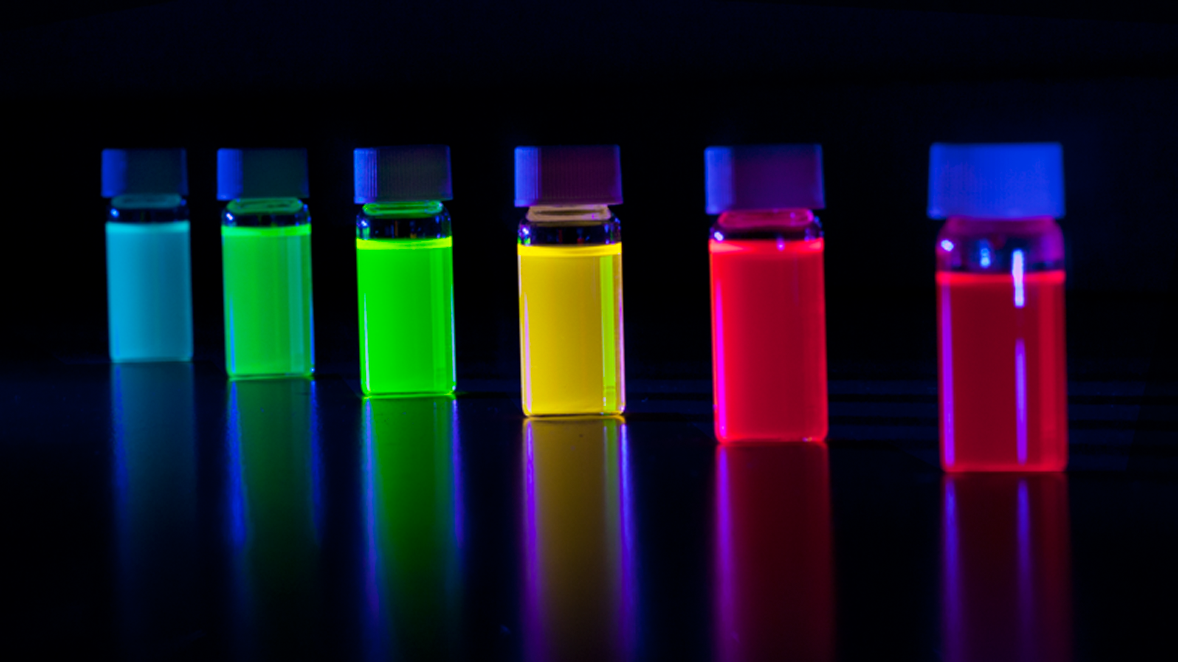4 Benefits of Avantama QDs over Alternative Products
The underlying difference between quantum dots (QDs) produced by Avantama and alternative products is their chemical composition. Established QDs are synthesized from organic compounds such as indium phosphide (InP) or cadmium selenide (CdSe). Avantama QDs are based on novel metal halide perovskites, such as cesium lead bromine (CsPbBr3). These novel compounds represent significant benefits over established QDs, particularly for application in the printed electronics and display sector.

This blog post will explore the four leading benefits of Avantama QDs over alternative products.
- Color: Determined by Chemical Composition
The defining characteristic of existing QDs is their ability to transmit light of highly-defined colors when excited by incident photons of blue light. Established QDs exhibit luminescent qualities that are defined by their nanoscale dimensions, which means that larger QDs typically emit light of longer wavelengths. Controlling the size of the particles is therefore crucial to maintaining an optimally narrow particle size distribution for enhanced color gamuts and higher dynamic ranges of color.
At Avantama, we tune the color of our QDs mainly by finely altering their chemical composition as opposed to their size. This enables simpler control of the emission wavelength, providing a more vibrant color output at lower manufacturing costs.
- Chemical Composition: Low Toxicity
One of the enduring drawbacks of QD technology is the inherent toxicity of the established materials. Cadmium is regulated by RoHS and classified in group 1 of the IARC (https://monographs.iarc.fr/agents-classified-by-the-iarc/) “carcinogenic to humans”. Indium phosphide is not as safe as many believe. It has been REACH regulated and is on the preliminary RoHS restriction list. The new classification by IARC into group 2A suggests that indium phosphide is “probably carcinogenic to humans”. More alarming, the accepted occupational exposure limit (OEL) for indium is more than 1,000 times lower than for lead and 10 times lower than for toxic cadmium.
Avantama QDs based on metal halide synthesis are cadmium-free and fully-RoHS compliant. This mitigates the risk of manufacturing and transportation personnel being exposed to potentially carcinogenic or toxic materials.
- Manufacturing: Easier and Cost-Efficient
In order to achieve suitable quantum efficiency and thermal stability, conventional quantum dots must be doped with an inorganic shell such as zinc sulfide. This represents a costly and multi-step manufacturing process that reduces the return on investment (ROI) for display manufacturers looking to compete with similarly expensive semiconductor manufacturing technologies such as organic light-emitting diodes (OLEDs).
Avantama QDs can be synthesized in a cost-effective single-step process. Our metal halide nanoparticles exhibit the highest possible quantum efficiency with inherently good thermal stability, eliminating the need for a stabilizing surface additive.
- Performance: Unmatched by Conventional QDs
The performance of Avantama QDs is currently unmatched on the display market. Our metal halide nanoparticles exhibit an absorbance per gram that is at least three times that of CdSe and more than ten times that of InP QDs, with quantum efficiencies of almost 100%. This allows the highest possible peak brightness currently available on LCD displays. The spectral output of our QDs also represents some of the best display color gamuts on the market, supporting the gradual realization of new Rec.2020 standards.
QDs from Avantama
Avantama is the leading supplier of metal halide perovskite QDs for the display sector. We continue to push the latter in terms of innovation for the optical and efficiency capacities of modern electronic displays.
Read more about the capacities of our QDs in; Comparing the Peak Brightness of OLED and QD Displays. Or, contact us if you would like to talk about your processing requirements in more detail.